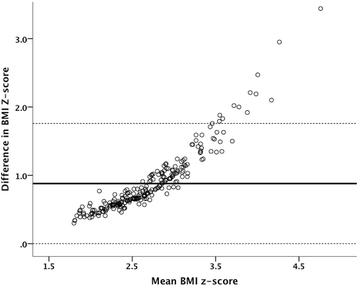Comparison between CDC and WHO BMI z-score and their relation with metabolic risk markers in Northern Portuguese obese adolescents
- PMID: 25969698
- PMCID: PMC4427917
- DOI: 10.1186/s13098-015-0022-7
Comparison between CDC and WHO BMI z-score and their relation with metabolic risk markers in Northern Portuguese obese adolescents
Abstract
Background: Growth-curves are an important tool for evaluating the anthropometric development in pediatrics. The different growth-curves available are based in different populations, what leads to different cut-offs. Pediatric obesity tracks into adulthood and is associated with increased cardiovascular risk. The accurate assessment of a child nutritional status using growth-curves can indicate individuals that are either obese or in risk of becoming obese, allowing an early intervention. Moreover, the association between the data obtained from growth-curves with specific metabolic risk factors further highlights the importance of these charts. This study aimed to evaluate the associations between body mass index z-score (BMIzsc), determined using the growth-curves from the Centre for Disease Control and Prevention (CDC) and from the World Health Organization (WHO), with cardiovascular risk factors, represented here by metabolic syndrome (MS) and insulin resistance (IR) related parameters. The study involved 246 obese adolescents (10-18 years, 122 females). MS was defined according to the International Diabetes Federation. IR was considered for HOMA-IR greater than 2.5.
Findings: No difference between both BMIzsc in identifying MS was noticeable by a ROC analysis. For both indexes the area-under-the-curve increased for older groups, particularly for males. CDC-BMIzsc was the best predictor of MS by logistic regression when all population was considered, however MS was better predicted by WHO-BMIzsc for females and by CDC-BMIzsc for males. Younger girls and older boys were in increased risk for MS. Similar results were obtained for IR.
Conclusions: A significant difference between the two BMIzsc regarding their association with MS and IR was not clear, being these associations weaker in younger individuals.
Keywords: BMI z-score; CDC; Insulin resistance; Metabolic syndrome; WHO.
Figures

Similar articles
-
The Homeostasis Model Assessment-adiponectin (HOMA-AD) is the most sensitive predictor of insulin resistance in obese children.Ann Endocrinol (Paris). 2012 Feb;73(1):26-33. doi: 10.1016/j.ando.2011.12.002. Epub 2012 Jan 20. Ann Endocrinol (Paris). 2012. PMID: 22265325
-
Metabolic alterations in adolescents with obstructive sleep apnea.Int J Pediatr Otorhinolaryngol. 2015 Dec;79(12):2368-73. doi: 10.1016/j.ijporl.2015.10.046. Epub 2015 Nov 3. Int J Pediatr Otorhinolaryngol. 2015. PMID: 26581829
-
Prevalence and risk factors of metabolic syndrome in Brazilian and Italian obese adolescents: a comparison study.Int J Clin Pract. 2008 Oct;62(10):1526-32. doi: 10.1111/j.1742-1241.2008.01826.x. Int J Clin Pract. 2008. PMID: 18822022
-
Relationship between childhood obesity cut-offs and metabolic and vascular comorbidities: comparative analysis of three growth standards.J Hum Nutr Diet. 2014 Apr;27 Suppl 2:75-83. doi: 10.1111/jhn.12140. Epub 2013 Jun 27. J Hum Nutr Diet. 2014. PMID: 23808870
-
Use of the waist-height ratio to predict metabolic syndrome in obese children and adolescents.J Paediatr Child Health. 2013 Apr;49(4):E281-7. doi: 10.1111/jpc.12147. Epub 2013 Mar 25. J Paediatr Child Health. 2013. PMID: 23521181
Cited by
-
Association Between Early-Life Exposure to Antibiotics and Development of Child Obesity: Population-Based Study in Italy.JMIR Public Health Surveill. 2024 May 31;10:e51734. doi: 10.2196/51734. JMIR Public Health Surveill. 2024. PMID: 38820573 Free PMC article.
-
Comparison of Different Anthropometric Indicators for Assessment of Nutritional Status Among Adolescent Girls in an Urban Resettlement Colony in New Delhi: A Cross-Sectional Study.Cureus. 2023 Apr 7;15(4):e37242. doi: 10.7759/cureus.37242. eCollection 2023 Apr. Cureus. 2023. PMID: 37162786 Free PMC article.
-
Defining a BMI Cut-Off Point for the Iranian Population: The Shiraz Heart Study.PLoS One. 2016 Aug 10;11(8):e0160639. doi: 10.1371/journal.pone.0160639. eCollection 2016. PLoS One. 2016. PMID: 27509026 Free PMC article.
References
-
- OECD. Health at a Glance 2009 - OECD Indicators. OECD Publishing; 2009;43–58. http://www.oecd.org/health/health-systems/44117530.pdf. Accessed 15 Fev 2015
LinkOut - more resources
Full Text Sources
Other Literature Sources

